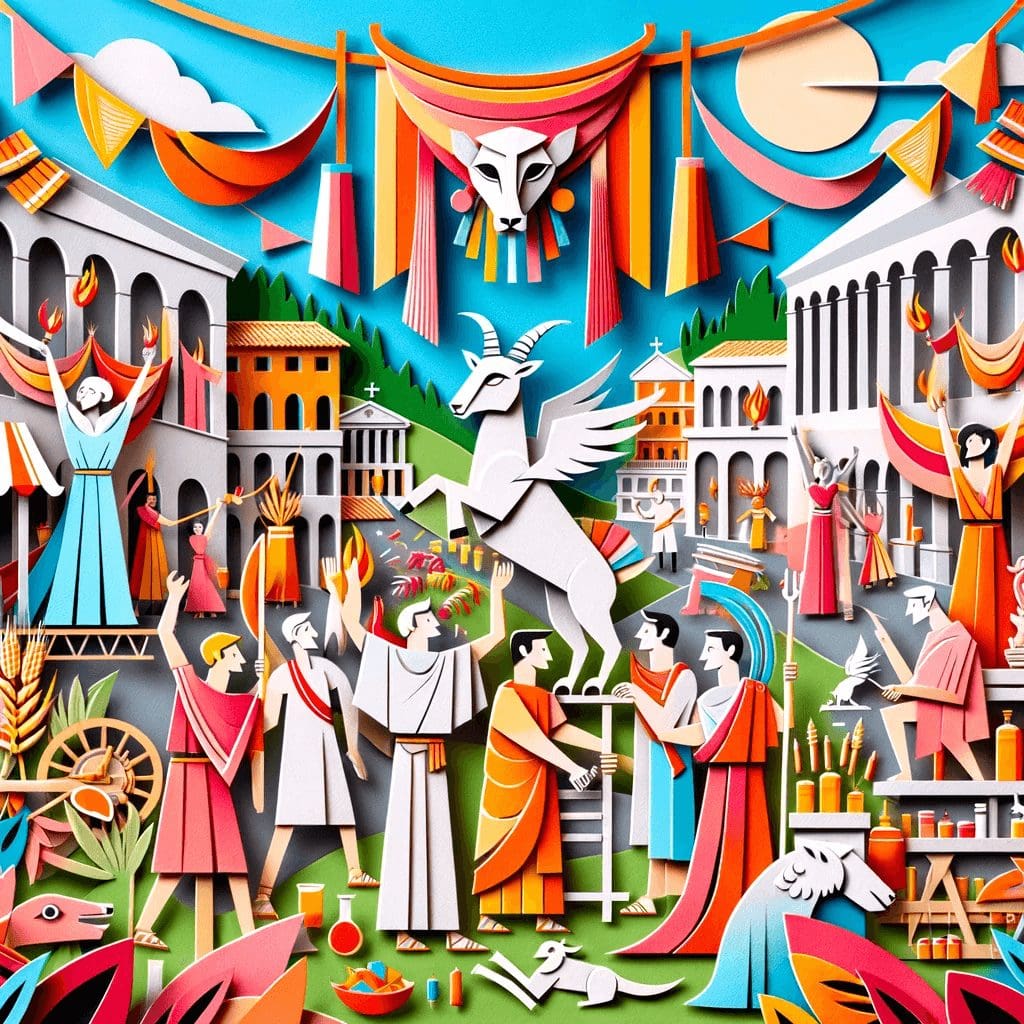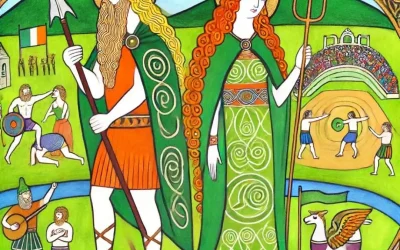LEARN | PAGAN HOLIDAYS | LUPERCALIA
EVERYTHING YOU NEED TO KNOW ABOUT LUPERCALIA
Published: January 24, 2024

Why Valentine’s Day is Pagan
Hello, busy Pagans! If you’re pondering why Valentine’s Day might feel more ancient and mysterious than a simple celebration of love, here’s a quick answer: Valentine’s Day has roots in the pagan festival of Lupercalia, a Roman event blending romance, fertility, and some quirky traditions. But there’s much more to this story. So, let’s dive in and unwrap the layers of this fascinating holiday.
The Pagan Origin of Valentine’s Day
Historical Crossroads: Valentine’s Day and Lupercalia
While Valentine’s Day is widely recognized as a celebration of love in modern times, its historical roots are far more intricate and, believe it or not, a bit wilder. The mid-February timing of Valentine’s Day intriguingly aligns with the ancient Roman festival of Lupercalia, celebrated on February 15th. This festival was primarily connected to the god Lupercus, often associated with shepherding and the protection of flocks, and also celebrated the legendary founders of Rome, Romulus, and Remus. Lupercalia was known for its unique blend of rituals, which included fertility rites and purification elements, making it a riotous and vibrant affair.
From Pagan Rites to Christian Feasts
As Christianity spread, efforts to ‘Christianize’ pagan traditions were commonplace. Lupercalia, with its overtly pagan elements, faced a rebranding. By the end of the 5th century, Pope Gelasius declared February 14th as St. Valentine’s Day, steering the narrative away from fertility rites to a more sanitized remembrance of St. Valentine. However, it took centuries for the day to evolve into the hallmark of romance we know today.
Lupercalia: A Comprehensive Guide
Before we delve into the essence of this enigmatic festival, it’s essential to acknowledge the shroud of mystery that envelops Lupercalia’s origins. Despite the lack of definitive records pinpointing its inception, historical traces suggest that the roots of this ancient festival extend deep into Rome’s storied past, reaching as far back as the 6th century B.C. This time-honored celebration, interwoven with Rome’s mythological and cultural fabric, presents a fascinating tableau of rituals and traditions that have intrigued scholars and history enthusiasts alike.
Unpacking the Name: Lupercalia
- Meaning of Lupercalia: ‘Lupercalia’ is believed to stem from ‘lupa,’ the she-wolf associated with Rome’s founders, symbolizing fertility and protection.
- Pronunciation: Say it like “loo-PAIR-cah-lee-ah.”
- Historical Validity: While shrouded in myth, Lupercalia’s impact on Roman culture and its link to later traditions are well-documented.
Lupercalia Fundamental
- When is Lupercalia: February 13th-15th
- Celebratory Reason: Lupercalia was a fertility festival, invoking blessings for agricultural abundance and personal fertility.
- Participants: Primarily the Luperci, Roman priests, but the festival engaged the entire community in its rituals.
- Venue: The festivities spanned from the sacred Lupercal cave to the heart of Rome, a testament to its societal significance.
- Inaugural Celebration: Traced back to the 6th century B.C., Lupercalia’s origins are as ancient as the founding myths of Rome.
How was Lupercalia Celebrated: A Blend of Fertility and Celebration
Imagine this: Roman priests, known as Luperci, gather in a sacred cave, the presumed sanctuary of Romulus and Remus, who were cared for by a she-wolf or ‘lupa.’ The festival kicks off with sacrifices—a goat for fertility and a dog for purification. Post-sacrifice, the real action begins. Priests slice the goat’s hide into strips, dip them in the sacrificial blood, and hit the streets. Here’s the twist: women actually welcome being gently slapped with these goat hides, believing it would enhance their fertility.
Is Lupercalia Still Celebrated?
If you think Lupercalia has packed its bags and left for good, think again. While the ancient Roman festival of Lupercalia doesn’t appear on our mainstream calendars, its pulse might still be felt in less visible corners of modern culture. It’s conceivable that some pagan communities or individuals with a deep reverence for historical traditions might observe a version of Lupercalia reimagined to fit contemporary contexts and beliefs. Though removed from the public eye and vastly different from the original Roman festival, these private celebrations could be seen as spiritual successors to Lupercalia, keeping the essence of the ancient rites alive in their own unique way. In this sense, the spirit of Lupercalia, with its themes of fertility, renewal, and community, may still whisper through time, finding resonance in select modern practices and observances outside the mainstream Valentine’s Day narrative.
Lupercalia Cards: An Ancient Matchmaking Charm
During Lupercalia, eligible women’s names were believed to be placed into an urn. These ‘Lupercalia cards’ may have been the precursors to today’s Valentine’s cards, serving as a means of identification and potentially carrying wishes or expressions of hope for future matches.
Characteristics of Lupercalia Cards
- She-wolf Lupa Symbols: Images or symbols of the she-wolf Lupa represent nurturing, protection, and Rome’s legendary origins.
- Symbols of Lupercus: Depictions or references to Lupercus, the god associated with shepherds, sometimes linked to fertility and protection.
- Inscriptions of Wishes: Rudimentary messages or well-wishes expressing hopes for fertility, successful matches, or blessings from the gods.
- Simple Artistic Styles: Given the historical period, the cards likely featured straightforward, rustic, artistic styles, emphasizing symbolic content over intricate design.

Cupid’s Path from Lupercalia to Valentine’s Day
While Cupid is now the quintessential symbol of love and the cherubic mascot of Valentine’s Day, the journey of this iconic figure through time offers a mesmerizing window into the evolution of cultural symbols and myths.
Cupid’s Origins
In Greek mythology, Cupid, known as Eros, was far from the benign, chubby cherub adorning today’s Valentine’s cards. Originally, he was portrayed as a formidable deity, wielding the profound powers of love and desire — forces that could both create and destroy. Over the centuries, the portrayal and perception of Eros/Cupid underwent a dramatic transformation, mirroring the shifting sands of cultural and societal norms.
Cupids Symbolic Journey
It’s tempting to draw parallels between the ancient themes of Lupercalia — with its raw celebration of fertility, creation, and the untamed forces of nature — and the potent powers traditionally attributed to Cupid. However, it’s crucial to tread this path with caution. While the conceptual themes of Lupercalia and the ancient depictions of Cupid share common ground in their celebration of life’s primal forces, a direct historical linkage between the deity Eros/Cupid and the Lupercalia festival remains a matter of scholarly interpretation rather than concrete evidence.
Nevertheless, the transition from the earthy, unabashed revelry of Lupercalia to the more refined, Christianized observance of St. Valentine’s Day marked a significant cultural shift. In this transition, symbols and deities, too, were reimagined. Cupid, in this cultural metamorphosis, was transformed from a commanding deity of desire into a delightful symbol of innocent, romantic love. This evolution of Cupid’s image from a formidable force to a benign figure parallels the broader societal journey from the raw, visceral celebration of Lupercalia to the gentle, romanticized essence of contemporary Valentine’s Day.
Cupid and Valentine’s Day
Today, Cupid stands as a universal emblem of love, his arrows metaphorically piercing hearts and igniting romantic sparks. Yet, this endearing image is a distant echo of his mythological origins and the ancient traditions that preceded the Valentine’s Day we celebrate. Cupid’s transformation from a deity of profound forces to the playful icon of love, encapsulates the intricate narrative of human celebration, adaptation, and the perennial allure of love and life’s renewing forces.
In exploring Cupid’s path from the potential thematic parallels with Lupercalia to his central role in modern Valentine’s Day celebrations, we’re reminded of humanity’s enduring fascination with love, its power to renew, and the ever-evolving tapestry of cultural symbols and traditions that continue to shape our collective imagination.
10 Easy Ways to Celebrate Lupercalia
Lupercalia, with its ancient roots in fertility, protection, and the celebration of life, offers a unique opportunity to connect with the rich tapestry of history and tradition. It’s a time to honor the primal forces of nature and the instinctive rhythms of the human spirit. As we remember the ancient rituals once performed in the heart of Rome, we can find modern ways to embody the essence of this historical festival. Here’s how you can celebrate Lupercalia in today’s world:
Craft Lupercalia Cards
Blend ancient charm and personal wishes in a creative tribute.
Sow Seeds Indoors
Start an indoor herb garden as a nod to the agricultural aspect of Lupercalia and the coming spring.
Create a Lupercalia Altar
Set up a small altar with symbols of Lupercalia, such as wolf figurines, representations of Romulus and Remus, and natural elements like branches or flowers.
Craft Fertility Amulets
Create simple amulets or charms representing fertility and protection. Use materials like red wool, seeds, or small stones.
Prepare a Rustic Feast
Host a meal featuring traditional Roman dishes or any hearty fare celebrating the earth’s abundance.
Participate in a Community Cleanup
Embrace the purification aspect of Lupercalia by organizing or joining a local nature clean-up.
Donate to Animal Shelters
In honor of the she-wolf Lupa, consider donating time or resources to a local animal shelter or wolf conservation charity.
Artistic Expression
Create art or crafts inspired by the themes of Lupercalia, such as drawings of wolves, pastoral landscapes, or traditional Roman motifs.
Reflect and Set Intention
Take a moment for personal reflection and set intentions for the coming year, focusing on themes of protection, fertility, and personal growth.
Share Stories
Share tales of Yule lore, fostering a sense of wonder and connection with ancient traditions.
Conclusion
As we’ve explored, Valentine’s Day, as celebrated today, is a tapestry woven with threads of ancient traditions, historical rebrandings, and cultural adaptations. From the raucous, fertility-themed Lupercalia to the saintly remembrances and finally, to the modern-day celebration of love, the evolution of this day reflects a fascinating interplay between the pagan and the sacred, the historical and the mythical.
Get the Monthly Newsletter!
Craving monthly magic in your inbox? Sign up for cosmic updates, Pagan holiday guides, moon magic, and witchy tips. It's your one-stop-shop for all things mystical – no spam, just enchantment!



